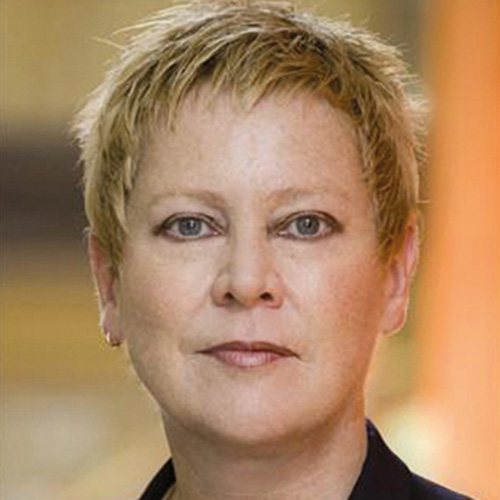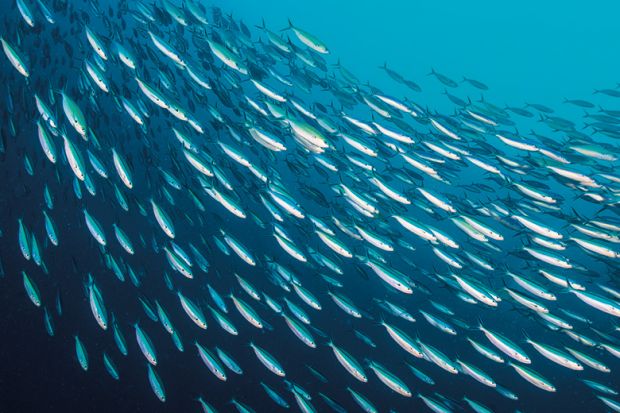Elspeth Probyn wants to eat the ocean. I want to eat her book. It is one of the most profound works I have read on the sea, and the issues with which it presents us, in the 21st century, not least because it dares to digress and move into territories that other writers and academics have hitherto neglected.
Confronting the notion that our future consumption of the ocean’s resources may end with us eating “jellyfish and chips”, Probyn takes apart the polarised politics of seafood. It is ironic that “enlightened” consumers turn to fish for reasons of ethics or health, when in fact its harvest is one of the most problematic that we humans engage in. Eating local, responsibly sourced fish sounds wonderful, but Probyn shows how this is at best “drenched in condescension”, and “fork-waving” advice, as disseminated in the media. And at worst, it is a drastically simplified and often class- and even race-based “choice”.
More than ever, we are culturally defined by what we eat; “our identities are forged through eating”. Set this against the particular anthropogenic threats facing the world’s oceans, and the mix becomes a potent one. It’s no excuse to say that you don’t eat fish, because you probably do. Probyn points out that 25 per cent of the global fish catch “ends up in strange places: as fertilizer, as food for pigs and poultry, as fish oil supplements, and, perhaps most ghoulish of all, as processed food for fish”. It even appears in supermarket white bread. We are all complicit in this global consumption.
As a gender and cultural studies scholar, Probyn also wants to queer the ocean. She takes particular pleasure in noting the common root of the words queer and athwart, and the sense in which the profundity (literal and metaphorical) of the ocean invites the other. Gender “is athwart history and experience” in this world. For her (and for this reviewer), this is a key question: the relationship between ourselves as a species and what Probyn likes to call the “more-than-human” – a nice term that addresses the increasingly apparent fluidity between species, as between genders. For her, the ocean is about loving the other and loving the same.
It is no good striking a pose, waving the fork. “Sustainability” becomes a mere slogan. No point in invoking some future Utopia – some middle-class perfection where we all shop locally, and righteously. Probyn observes: “Of course many people, including queers like myself, will not have grandchildren to whom we are supposedly bequeathing our efforts to save the oceans”. (She notes that Rachel Carson, author of Silent Spring and The Sea Around Us, was frustrated in her early environmentalism by misogynist politicians who wondered “why a spinster with no children was so concerned about genetics”. Elaine Morgan, who promoted the alternative evolutionary theory of the aquatic ape in the 1980s, met with similar masculine opposition). There is no “presumably remediable future”, in Probyn’s reading. Rather, only the pragmatic, practical moment in which we find ourselves in the problematic act of eating the ocean.
As Probyn notes, women are almost entirely factored out of the industrial debate, yet are vitally part of the production. Women catch an estimated one-quarter of the seafood harvested globally. Probyn remarks on the “misogynistic intent” of the term “fishwife”, quoting Jane Nadel-Klein’s Fishing for Heritage: Modernity and Loss Along the Scottish Coast: “The women who dealt with fish [were seen] as brash, brazen, and unclean…the stench of rotting fish [standing] in for the odors of female genitalia.” Conversely, men made unemployed by the 1992 collapse of cod stocks off Newfoundland were “feminized” by their lack of work, a “ruined gender” (in Dona Lee Davis’ phrase), and “more like a woman than a man”.
In an excellent section on herring “quines” – the women who enabled the great herring fisheries of the North East of Britain in the 19th and 20th centuries – Probyn notes that it was working women who carried fishermen to their boats to stop their leather boots from getting wet. Vividly, she quotes the writer Charles Richard Weld, who in 1860 remarked on the fact that the herring quines preparing the “silver darlings” became so covered in fish scales that they began to look like herring themselves. With a wry dig at Darwin’s theories, Weld wrote, “If a man may become a monkey, or has been a whale, why should not a Caithness damsel become herring?”
Probyn writes as an academic, but she acts physically, immersively, with her subject, at one point resorting to swimming with bluefin tuna to interrogate these problematic fish. (“They can go from zero to fifty miles per hour, faster than a Porsche. I just hope that they brake well.”) Or rather, she confronts herself with the problems that they propose for us. The crisis over bluefin tuna addresses the key notions of consumption that are at the heart of Probyn’s book. She points out that the Japanese taste for bluefin – that prompted one Tokyo businessman to pay $1.76 million (£1.4 million) in 2013 for a single fish – was instituted by the Allied powers in the post-war period, much as they also encouraged the Japanese to pursue whaling as an industry, to feed a starving nation. Mitsubishi, the car company, are also the world’s biggest bluefin brokers, Probyn notes with due irony. “They have a large amount of frozen tuna in stock to be released as the price goes ever up...When the last bluefin is caught, Mitsubishi will have stocks of the extinct fish.”
From the spiky bluefin, the Hemingway-esque symbol of a macho struggle with the sea, Probyn takes us into the sensual world of the oyster. She reads queerness into its clammy otherness in a wondrous way. “Oyster eating is a rare instance when live flesh meets live flesh”, she notes, “when ‘I eat an oyster,’ it also becomes clear that ‘an oyster eats me.’” (Peter Singer, the great writer and philosopher on animal rights, has memorably drawn the line between prawns and oysters; the latter, he suggests, might even be eaten by vegetarians.) “Tonguing and tasting an oyster is something you do mindfully with all your body,” Probyn writes. I can only agree. When I swim in the cold waters off Cape Cod it makes perfect sense to eat oysters afterwards. Each crusted shell contains an ocean, a kind of communion that speaks to our own sea-ness: the where-we-came-from, the inexorable magnetic attraction that we feel for the sublime element to which we owe our lives.
Drawing parallels with the unsustainable production of protein on land, Probyn notes that modern fish farms – that supply more than half of all seafood produced for human consumption, and whose environmental reputation she is at pains to rehabilitate – are in fact a much better way of feeding humanity, especially if “multitrophic” systems, which employ a cycle of waste feeding other organisms and use seaweed instead of other fish or soya beans as fodder – are implemented. But the industry still requires “fish that are fed to fish”. What we really need to do is to eat “little fish”, she says: anchovies, sardines, menhaden – adding to the list “bivalves, algae, and marine stuff that doesn’t need a lot of other marine stuff to grow”.
One of the book’s truly positive passages deals with conservationist Patricia Majluf’s successful campaign to persuade her fellow Peruvians to start eating Peru’s plentiful catch of anchovies. It was especially effective among the poor. Instead of going off to Chinese processing plants to feed bigger fish, the anchovies were eaten at home, with domestic consumption rising from 10,000 tons in 2006 to 190,000 tons in 2010. Such stories, so beautifully recounted, leave us asking the author the ultimate question. In the face of all the evidence, and all the fork-wavers, what do we do? “Try to eat the ocean better,” is Probyn’s simple advice. “Try to eat with the ocean.”
Philip Hoare is professor of creative writing, University of Southampton, and author, most recently, of The Sea Inside (2013).
Eating the Ocean
By Elspeth Probyn
Duke University Press, 200pp, £66.00 and £18.99
ISBN 9780822362135 and 2357
Published 9 December 2016
The author

Elspeth Probyn, professor of gender and cultural studies at the University of Sydney, was “an army brat” who was “born in Calgary, moved to Germany, and then to British Columbia and Ontario. We moved to mid-Wales when my father retired.
“My mother came from the Okanagan Valley in southern British Columbia, where she taught me to swim when I was two in the 90-mile long Okanagan Lake. My father (to whom my book is dedicated) was an avid fisher, and every year when I was a teen we went to Findochty on the Moray Firth coast where we all fished, ate free crab that the fishermen couldn’t sell, went to what were then flourishing fish markets, and watched our parents drank single malts! Whenever I’d see a body of water I would want to swim in it. My parents encouraged us to get out and do interesting things.”
Probyn took her undergraduate degree at the University of British Columbia. “I managed to get myself in when I was 16, and had to work in bars to support myself. So it was a strange time, but I learned lots from travelling and working in all sorts of places, including Corsica and the south of France. When I finally ‘found’ myself in feminist cultural studies in my master’s and PhD, I became incredibly focused and driven – by fear. I’ve chilled out since meeting my Scottish partner 15 years ago.”
Is the ocean a queer place?
“Yes indeed – how couldn’t she be, with all those cross-currents and such a variety of life forms? I’ve swum in the Pacific in many places, as well as the Atlantic, and in the Med – which is sadly pretty sorry now. But the Pacific in Australia is quite different to anything I’d encountered before. She can be very angry as well as beautiful. I’ve had a few near-fatal scrapes in rips, and I have learned to fear and respect her.”
Her fish-eating habits changed in the course of writing this book, Probyn confirms. “I was a pescavore until I moved to Australia, and started eating meat again. I became a pescavore in the hope that we could better redistribute food resources around the world if we didn’t put so much resources into producing meat. I don’t really think that there is anything intrinsically better ethically about eating fish or meat – depending of course on the conditions of production. I now have sardines in the front of my mind when thinking about lunch. I do still love tinned tuna – pole-caught of course – but sardines and anchovies are so much better for you and for the fish populations. And I continue to love oysters and eat them wherever I can.”
Of her adventures swimming with tuna, Probyn says, “I love swimming and I thought that it would be an interesting angle into what was then a short article. But it sort of took over and assumed a much larger importance, and it was compounded by visiting aquariums. I find it very hard to eat farmed salmon and I would never again eat bluefin.”
What gives her hope? “Probably my students. At the end of each week we have a great seminar with about 60 grad students and staff and then go for a drink. I always leave work feeling more hopeful.”
Karen Shook
POSTSCRIPT:
Print headline: Teach a man to fish and he will feed forever
Register to continue
Why register?
- Registration is free and only takes a moment
- Once registered, you can read 3 articles a month
- Sign up for our newsletter
Subscribe
Or subscribe for unlimited access to:
- Unlimited access to news, views, insights & reviews
- Digital editions
- Digital access to THE’s university and college rankings analysis
Already registered or a current subscriber? Login






